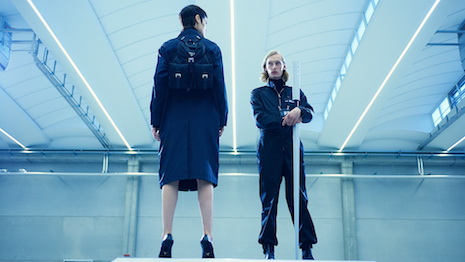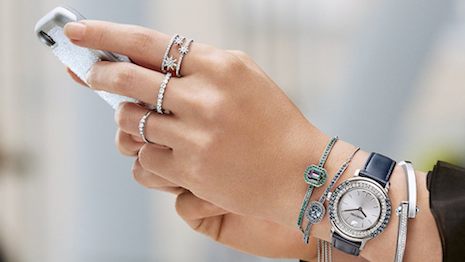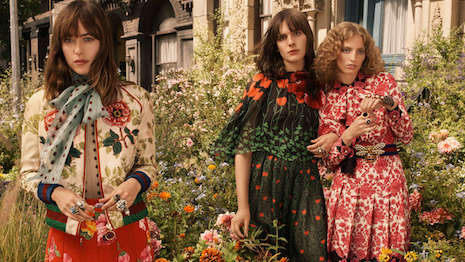Even as the luxury business grows and retail sales climb, the high-end fashion and leather goods sector is facing questions of relevancy as consumer tastes evolve.
Sustainability and minimalism are two trends influencing shoppers’ decisions, particularly younger consumers such as millennials and Generation Z consumers. During a webinar hosted by Luxury Daily on May 15, panelists also noted how the concept of luxury itself is changing, which needs to be reflected in brands’ marketing efforts.
“Brands need to be constantly evolving because consumers are constantly evolving,” said Beth Goldstein, executive director and industry analyst for accessories and footwear at NPD Group. “Younger consumers don’t necessarily think they need to own everything, or that they need to own everything new.”
Utilitarian minimalism
Expectations are starting to change at a rapid pace across consumer groups and sectors.
Despite the saturation of options in the fashion sector, driven by fast fashion, many consumers are looking to simplify their lives and own fewer belongings.

Consumers want luxury goods that are both fashionable and functional. Image courtesy of Prada
Some brands are encouraging their own clients to buy less but buy better.
“Brands and retailers are stepping up their sustainability goals,” Ms. Goldstein said.
Ms. Goldstein noted the surging popularity of decluttering guru Marie Kondo and the growth of secondhand apparel and rental platforms such as Rebag, The RealReal and Rent the Runway. Retailers Farfetch and Neiman Marcus are also investing in the circular economy with resale partnerships.
Danilo Venturi, director at Italian fashion school Polimoda, agreed that sustainability is one of the leading challenges facing the fashion and leather goods industries.
“Leather goods can be more sustainable than artificial materials,” Mr. Venturi said, explaining that these products have long lifespans, particularly in the case of secondhand and vintage leather.
Reflecting their desire for minimalism, consumers are looking for multifunctional products.
For instance, Ms. Goldstein noted that there are more convertible handbags, which can be worn in multiple ways, on the market than in the past. Previous research from NPD Group shows that consumers are interested in accessories that provide both function and luxury (see story).
Interest in utilitarian pieces is also helping drive the growth of luxury footwear and athleisure. Meanwhile, sales for fashion accessories have softened.
Brands are starting to recognize that not only have consumer tastes changed, but their shopping habits have as well.

Brands needs to be easily accessible on mobile. Image credit: Swarovski
Mobile is increasing becoming a vital touchpoint in reaching consumers. Marketing content needs to be informative and easily available, especially since millennials are primarily engaging on social media and have little interest in searching multiple sites as they shop.
“The physical store is not necessarily the flagship as much as the ecommerce storefront,” said Tom Strollo, global lead at CreativeDrive/Fashion and Beauty (CDFB).
Changing POV
Many brands are looking to improve their content, particularly closer to the point of purchase.
Since younger consumers want to feel as if they belong to communities, marketing also needs to reflect diversity. This also includes geographic diversity so that brands can reach both urban and suburban consumers.
Panelists encouraged brands to optimize creative content to relate to wide audiences.
“Collaborations can be very effective and help brands stay fresh, especially heritage brands that have been around for awhile,” Mr. Strollo said.
For instance, Italian fashion label Versace and the streetwear label Kith recently worked together for a collaborative collection.
The 100 co-branded pieces drew from silhouettes designed by Kith and featured fabrics sourced by Versace, combining both of their aesthetics. For the joint venture, the Versace Medusa logo was given its first redesign, with the Kith brand name covering the mythical figure’s eyes (see story).
Panelists also agreed that Italian fashion label Gucci is one of the leaders in harnessing creative digital efforts to remain relevant and inclusive.
Last year, Gucci introduced Gucci Equilibrium, a microsite that delves into the brand’s efforts regarding people and the planet. Gucci is also focused on developing new ways of doing business, from adopting more sustainable processes to fostering ideas at its ArtLab leather center of excellence (see story).
The label also changed its retail strategy with the opening of Gucci Garden in Florence. Envisioned by Gucci creative director Alessandro Michele, the museum-like space includes a store retailing one-of-a-kind merchandise and a dining concept (see story).
“Brand management will become more and more culture management,” Polimoda’s Mr. Venturi said.
{"ct":"1RbPdgSNf3S6FBxFEdfW6q17knpSQYR6OG6SuAudqp8bqdXqJdxV6DmygfmjlbqayFKc7ONZkCvvemou09cFNJSCGTu6voRtjyz\/oOs3ehfT0iZD55ENUmV8E3BsJGQPbhLUDTtAJauWiQ4jHktHZQ8IUBcaeLkXC6IcZBzDsZC4DzcbRZnnwziyNmWeBgUiHaPYMBknXvwpxlIwRZIZy0\/H6ZDKQjPbfx6hEva3zd37G2yiN8PYY2rXBIe8gn5N9OHuKukcPoNmYuUj2ME\/kxFpxzEYObzxeqonCivCbe4LK3Q04Dx3yJVKisvVuRN5RGY8jepuW6xwC865ED4Rn4gublEOaZ+6YOhY9ajD72x1kzE6cjhwF9yqYO8QKEjoH1m5yL5pwEx40IJKKMn4pv19vkAR3ka+C4UlgEDytvvgcp6f099sA4OND8U9z1BD45sDQlmW6Dpe1aF93TkRIp\/RXB60RUTKpjYQ+FRwLjAzCNDM\/MmXkXIA83hn\/SeAiNat8jZFVf+aXGTqnmcwTJ7aH5DgPcDufctnbrLeWjEyXTJP52OHIsBgdOIpeJEgI4ODpvUnx9mEpuMKfF7U41+6QbSPPyqqBOjGvOzFzusf+ZckqHkywF0brJmd0WpCRehbg59UWjTMM2hw9R0fuSvJsY6EJhFmZXYTvlmDrI5mTkE5meG+Qa1\/HiaS\/+XVV2Ciyp5lLRZq3w77fR9Ua6BvrYBhIXVND8Ecs72Y3vwu4DRrgyLtgSH\/olLZMYB80vj7Kx0lzPGv3JMHUdIOdYvsvQgJYRhjV2zJPTJol5R8KnNgIIOktYnc4OyaQOk3lDum3pS312+0iyiDPgxbsvkARPdZF3hrDJX3BiKohFa\/4Cx8ehUfy5+r49X5BKB9qiiRwXrmgj2rftOlw7S8HxWetQt+d2NbyUpMYAUEP9pOfPt\/9a1748ipRui4LdDtI\/e53fssl813\/vqSXdnX6uQwIyoHM19XwB6IaBpNSTQ03h\/uJ3ICpznH5lJa6DEycf2zOewPwUfbPCw1CFY7ah24v+hfYl1WSmyD1\/MNiQeP1\/DyIaMR\/NWVfytg+5ao7PzH1eDXMgP9VR4e3FrmXb8JwXyYqKy5ZuPAtz8wwG5ci7JoARvqZnRWMthIJd2A+un\/asxYUsuVe5Xw+SGuPlWdHfTodNnQk39gY94bwmWLWtpcovQyXtK2EenQWwXG6GRV8mFl1O1gfx5HodugWfn8ytzDYqMkDYUzd8TX53X0aiIjRjzGVaDrRY8\/vYqxfJJMLFmiQucb4byhC5ABt3E\/JziDJhJcWeloa\/qNFeFpUqm\/6OpkCs3VX+T6oSVPyYxN5sc2UHmlfn+aWAbaJdGfB0mjYe8MqHzVNG+X7bcG0NGS\/G\/j7ZBUR40lDPIuaCobahUoEvuZwAXtPPjMbrvhiZPWn2Kp2LS3b+IweFdDpKasPZ1YD4Z0PYi7i+XbU\/rZ910yW5M4OuXJQsbAhXmFwToqN9uGqn5a3hYJycmghSjUUcHSyB+YaY5ZSGjLiUU2MgnIsJXPpgbb41snlCbdXOlQn7LOgxnHrH6J6dgL0nGV5sR+wv9cJNr0pahBJnyOx9vWSUydSsIA5gFuP9jyLGX\/GwxH\/27TaIhmPT\/eNf\/OHBe8IGM9ejP6otjKS0lH7M1bWhHO81NnBHpp\/51k5ccp9qnel\/7kerCdPJnFl40gFmfmi+WXd4aB4+FBKvG2Pt4JwRk2Op8GBrR56UI3NiE3Oj6+1B73MA\/Hq3CypCHLCCAVzivcIyRjdnt4rR6c5X\/1zt3TF4CEIUz5RRQdkqZsda59vcdle914a8VVuRlTWXObTCbZOX4Fnhsb2iSmeyJb6oo5ICmNn9G6rdAW7Pz7Ygn\/c2ou3ILa6v\/1iYjVfqodgi9fNOQebMO\/90iG9XBIqQmd\/VIIVIqtZ1rlFtZLIyzNowaWKYy4nwkFV67Qe5tJZXmx5Yh50J5MvAXm6AchGwOB6hyxCw6eZmlB4o33FNM5aaR9C\/rsUs1t7K7WsVPQQ9iwJdB4ayKIgoBqz9aMcMmuCZkoyikMIr8vqpZC9VBI7LnPz8Rpq1JFUxpdrGth2KSScYDsbQ+YBcdhQ677dz+nac+SPByb1FTkobDz6fALpPIVVOysTeCNcMOOXGp5GG4J\/TvsQuFBlwHm2h5cS1aDn\/j6hF2WMwBRo6P70jmN+kIiyDmiVV22xDnZ3VDon4gmOafVdxYitQXT9IRqcPl\/\/u8xp5XuWlluJgJ0bZXmmp3ehu7rNkS6dajKxadd981QSU9KVE+Xzy0w+KBDzASDxQEKHvAP9kvAVQzVNFf4uNdTQMw0wWPIAhzLYQrFs19gEybbqFho9+IfSD0l4W\/GiLjNMqJx23HoNJiizY6HpgNOqNaPph0U7bXGmFPV4tm54PmPwC5OyIzzXovwI7vxZG6kyC73sfIWKT7b6EbmvAK7OMp9KUO0gBes8pDEAWeGmy1vhFe8E5tjmTG3opYJ1n2v0\/Yxgb5dH8bAZgnXIvYP4mtYhc\/C6VSS6FPWyrRpGSketaLdkwKSy94hWUcg650qXRbXRgep7KJhj+Vtlu9sqkbtm9gd3w\/QeCPtpR4u5fhvFvN3Cc+Z76mh\/tqrNsNhtRkeb0zr96V3l8zZmahWPiGdx65mouy7Cz025RfXWujuHQbTPkFf+N+Z1\/pIiptjLGPNFw8gIEAUQzQaQ9zAeOFWJ4XsZewLsEGqXwSJxT5Wk+4DxRlikkojLyDorGSw3qSke3VZquepK+iFdq9Ov1XMdUkPmw85Y1eTkbM+9QLP96Ya7Oe6cA9\/trCj5NLP1PLRbBCJlAD2QJ8P46ZtuFV6ZCJCnUd+P99E9\/J1ExAVMeaoSbCWFoCJBYUf5B\/YwPKNrHKOzDmeCr7QeqkAyaGogviGw6L5WG5T77psGvOjcyB3jEK12WweLdrfBA\/B0ISbh3n6PnXjHvk+PreZHlJ095IuJrYsIiT8swOGhcpKKfDuPnpdvrUimDvfB8BT\/fp\/zigB64E5omQs131wn\/Dl4jP4kPng0DXBV7KewOoKTvr1VyvmpUiDFSkHQgwuLuHRhFIxuINm2qIrFCbThPe9f0EyrvRCS1UI\/zFszoe6LBg32CsKeQR9zcVL1B0j1bgcBSerZpz1yZeGmRszpojMRRWhDaT2G7YVEN3B0k845Oz4QcTumYyx80U0YV\/TBxYvELnkIFbvZfVPQwTmoGEL2sGfrJJIqur9wUtXaqEkB7qPUEwdEzEJtDSP+h5Jtd9PKhn3FlU8M8fvHxUmUa2WV+gfYrR+pErT6MT\/IH+EzQYS+2i6fuGHhhygAjgKrGhZCNANS6zGblePerJGAyWuZSxUxPHKXP7Pic25BVgv\/ppKp9\/4hvV6huNCfjYYhEbs6ztcgYouqjc+OHdA4mKDRbuJbawI7wiOI3kdflbHO2UVsJIAF1yu3pXabF4Wdj3xeXUYeih5\/UK9vjUi42TYjndBfFyiOw\/oWuu0atHTZBmG6OYulxons0Ip90bkujPYZvTqSiMPb+k9mDqik+nf38Qa7yKxwtF2j8R2lsxwDDTWPGvuoP1noWzZqW8WzXFABk2lWONv3wXRsYIR3qlXPeHQhH9mb1vM3lSVVfBMJyEtI6nEpbUfvmd9EV2KOlNN6eF7qJ05nngN+fruMEH37EJ44hwoxY4H\/SZBHa2uo0k56R1siT+2T92Vgcsk8wE8OUgB0kIv5VDsZD+0LQWWoFYv2T0mIKDThaqeaIFCI+2GPotNMJ4vMLDmGEOjpRvl7owuVGYPsmI5KS3dGJDpFIeTNhnUrjuulIQ3RA4lKnmLh2pPoQDSQ\/ER\/0SWlQXSCsu4LX248UmKClJ2WKjC31VABObevl+cea7CP7MOuSGk11pV2SDNSc+y5ymByeozessV6a0WiWP5v72+FC5PJ2OrPf3xmAUC7jGWMaVpgvzc4zApZi7HmnUkMRof13LhNXDMikqitWCZ6kZQ2tOEhaXlMxLWhsDzjocQFVUkbQ7WoxouNSFhAiXyQUXCk0m1QQgTOlfWpJejBeaCXsrnJZCr6wEnBmpX\/Mt6d7PvyzyPHWFQeuJhAkYPrl+Ky5WeKnnqh8dY\/\/0rhvB608gGslzfgFbFpNpL9Ab\/92j3rh32FAbKT+B97Fsy5XeJTQg19BMr9yvgVVtb0XFboA\/kx3Re4cywD50PjhSSVuDZ2aldp4SS6Vr+WKED4MtX694fbr9rx6yrG9uTmZpxU9wkz2NLoDScmuFv4Jz2b7v+zOYaCzLSTYYKmrhVGobp1R6zRgkfHxxz4scsaM7mxmY5VnJPBbJ7\/\/Ymlafa0FA8mYW2hruALS39J3AwLq+jbWDSoZVE19wHezGrfw34CWRiI\/fwR\/7xekv4ZWZbWq7EQSTaR7bqzUF1prvCm6guJyg6uU7G\/by1NgzKBaRRSoV0e+iyR9mXxZfHJ5Rt2MK3alu7xsm8rkN6RYjbFw97lSwRLL7C1kW4YsjpWsFp\/lkYmEZUaoEzyZF+mMo5pQtQ4UwaWcG2i1wAmRnbUZrxkPmShSQxSudBPGWWF4aRJa23QxPXF+Kidf7p+o5Wg9B9kUQRcR4Jkt44OsONqPfyRmXRC6z5jwh8zIhRvmIn\/9UBzd6Q7orSF3mk7ScrmRi7VcPrlYsU07bHEzOoiEut+02YWPlTXJktEHlWQpRbwlDIUE8paybRY4CZ5JoHngSLiXgrBAXIqh0yWuXYE2GW5sjWqE17uBsUdmkdVJwWWO+iyFLXHPwyFOboMBxAgPrZZq8\/ESvA09tI69w6iSzHbo1pK\/VYuqyD6zxdeFy7a1afrNghIVD1kgLMr\/IFOiQtU3ePGg7LnVLj84LdBHEpSyMo36s0\/nd6YljOocumvl0bT2o0URJEL\/qPVYxRHGbECoAdnkwPpsbIsQCPTIxs97jmZx7MmZMVYMNfF1XP9vB2qWym+tDgGtfBrzi9ZxOYRh\/f9AC1RqJEaJ1uwYVEyIi\/AnoInrMJ0S1\/clLjXOLwSwaRt4jruvEkiTsZ4MWDhU0jc5Y7NQZ\/VMug+FoYXyGNVqUsdvr9fVC5WuJ8QlYFsqVE7HbcQcisrw7eqae6tpBKgcnqVpgijPHe4mloqqlF\/jZe\/LHucGZc\/cbXm1jyw0fkFH9bigFjD33Hbll4yId26FL++wQbRzYn3iFTMEKLEz76qFYlOyg7GOkp0ODbq1FTzX1RQOyVMRflcTM6IgllUGSwF5WmMNNojmpy\/yeZUhCeZ2zOjKdo1z3ciN4KW60pyjEgDg9n1Pv78LNRHod6GoAgExPCNYhw62LyobbisNJBZ\/0Y9oal7V4GeoRjmmoUYr+j4aqCeSNEHfJeaYZdOQ1qsbrc\/+KExz5ww2edoboqstBDNN1a\/DIbQKhh5Xtcy4nydxvV8qcx+hH3ZlfEJdJfjG9S7+6gbmWr9bbAYJM7WQhbJ1yuehDVZwetr7xzMx1kaiUnExSIl9GM\/fuFkadW0JTKUjNO+zp84fsuzf3iXQHmvP5m\/07FH7ZPqwf8N9I\/U\/FBV99h5a3XUdIE1Pfqq\/cBAnaIzz1BL56hufYTYR4GXREopLxjhwa3gmENhxl4OSb5bN++MBvAbnYqSQ3rCj\/czJe3D4+iKlM1nA7MJYpCusSMSwdtDdylPMiFrNhhCztS2YsyIXTqyemzf8+Y5oHvoAyaUFTBsXtW7G8b6D3hGCe\/EXKFKRMbPC0HrpAwzAR3VyZ98w4ZBd8cm24gDykp44TTm+i3gmhSF9OOc0D34z5dhNLt6UWffIQw\/5TDsU4ZH0bfG7duAlUf4wOj9BVVknJpA4XaJVSgQVwQMEJc7ble\/iL5cVaqBOS5WHJYxzQi1c8X4GR7MJDBEoqRgfEd5qOUKpcgzfh\/Ns01itT9x2jeA5Kumh2et+dLgMuo2LOjFo5kzbjstiOuUvrx8v0LMS\/FUQ\/v+CxvL4EbH4M9AmNjcIgMmFVHkHpKDDvdjykg6JlE5XAa5N3b0zySoNkk8wNSNaUeWCWmmy4of9c9nVkbtEu83N1EoARjCB\/4IbQNK21Xsbq60c\/EEQJYx2vH3YjAE5o2HTNQ8FZLLEY2yTcnk5vZ7UjXKZoVRRYXq7fSGrDVFBu6d40TPYkb00qiTYa+HS8FwYVMxg\/wael0IgL0p+s\/ihxATl+JRi9ACKX\/VPFN7PkCsMhhwmXAiv4PLv\/FL\/S8QvIs19MSDnK2Y+yasoXgbeddgYKCGcoq0E1cLyIgu7yYBneq0oVTHuBLm4FvcYvG7YLy2sHaLDIBC2Eo+Ef\/OFO6K08qeJWxYq8Xb6ibA6JOHtWRnRjJmE7wWXGjMU3btgP3G0gWdUBOLnSo87tIzPujIy9ztVd+6PiYdRYFtrusA8onmMJw40MXFByyuDlk7oMJKblyraA0XgwiAPf9Lc4wlY4LuNP5sHvcLzeNXMgAB11HBMa4HbI1aBmCsxre19qv9GuoKL5BmafeMKkrk77Ue4Ej0nxoqqGc\/LxbUkCPNGoGI3AdLqXi+iDDdTw9PePT9mY3+XBHphUVNIT4aoOsXnHI\/icC\/PdEKUf50\/odOw+kqo\/YPjQ9\/dg2EArLPeZXnfPrAvt0BbHhA9qjhcWgxTHibQZDnvS\/7d8v2k4r8uiw6R+8+xBNlb9kdNTYlHOYhYDenQ3crEFiO\/xdjK3ahrI1hP9CNQfvIEfkgS1bypNWp7k8SLbFCws6mkHhbkrk4huMGgGEjKN3C1BRc\/MsMLSADRFlPU0wHYJ89DPQ6qjJ6QJFnz1hncDWrR21jTfHcGvorEDNHCrA7pVCeoHIv9299\/K+Tv0o2AMNKvOOTDyWV2MPIAbapOc7ZrH5o7itm9G\/StJBU+zP4ZyLWrxK2CLknC8Wag7ATih9foGb+hRYyKSJw+l17+qVZMIRcPhrRooJ7tILFoyyJQSVRADoKaAuidEzIKgKZRw9SzknUZ2jjK3TErHyFdK6nQ6SMfdEuR4RGXqJMSZWjchZV6Tw06P0o+Cpfu+Sp\/SDRrLqyyb+caVmhpVVsbZleAum3jVsZDSzcXSm5rNPc9Aw0nIKDYwscJPkrL6eImUeckRxipXYUKNH92qwvRTLFxexAnm3HLySBMQACBOD3rshyODZ5GmvXzmrbZO8InF+66jMX4Wa\/n+aK9qF1FO8fGLJkq7e2MvLgzofOvocTq8cqxynrKFl03jGt5rqOnV0sTlpHIMq62EDsLeB5nxVkWUyobBYNR\/VK2yysJhTT6nl5H3NMGsHjpgoGzjfiN6EgXXHONizde8VUhUcGJDipKSbISCsq8UsDXiz9XHWf6EjqEW0ehT8x\/s1w2NITYu5JRvJBErVQwhcw5A+sMgYuRoBcwHbyaAVJJhTCT3DIVA\/3RDzzgFukjpaoUOPOtw+JwVId7D9YMZfXD4ycYY1vfgx0P5mOS+9Y9v9ymd4F6v6Od7u8uNYa1dm4C4ipC1zEAc+UMTuPZK7yOTxuUQJgD2sMVvuTgMLvdpU1azRRo9VgRXUz0KS7d6kVPASgETivkxTLqhA453gOP7cy3VYii8S1AAy5yL7ovGynutvnFLUv7mSZNxPhWSYRaBZGbI2IdfLWyoEmxSDw1bTD0aHhGJ1dzwVNaGFIFnAk991DP1M7iWu5XBLcHnNbnf2e180yty6X6vunUMOnWcC5StUDCZQ97hgYy48MYBRRk6ABLwY\/2DX0Y5sJdCaxCt0E7+cbkivPMrv5cVg01IJlWUNonlINx9n\/JlT1BtD1NfKUfdYcmHNinLoVD3YcIs6KZT4S0QmlLpnxrH9BqBOEOdj73LbuAjbeag+Ucuk65cGCXugYFsoGqU4DUpK1n2hsBgCyD+XGRVsx1QLMe192eNFDBm+vbtUOjnN9+ONCvGtSCerKbt+ct1oE+JNnSHTdGc91yuiB3HSZDQFM6rkNludn2oqPmWXCeSxCY+4ely29hb1FB64Hm8CQ3i57arNg6tq9eIFFaLnOezpjdgenwGP1eARt9ZCs3H0f7boYkfD4ALAJlGjBX\/OzySEbnSi5N3pKh7VCCuanIvBIW9v6yWAK9pMBioSJH8Mi8IFsPQqt7K+Ggk04ta9hnn8v0fuElHjhq\/t\/WWCjzhuqWRsHMSLFukcxdEwa1q\/DiNbYkzYWPFi54MAhlHWDEvRGJ9AVnrd\/3qPFOd1tH50FKh4ViTUG9rvSDdzqA3YsFdysLbUms2lC8C49HpvNFiFjMNShCIwjppY\/EAjy+QjqUPg8Q09jQMp50PAk8J9xT3x4gF6HXi0Pl+6gfwZPJV0ibrFFeI5vuosk7BUXyNf7eWZxEP3X06\/NNRbeWpYR9bUTQWo4ZL2qBs+17ViwKT9+YtJsR7WwNVzFpqMJAnTJeJxdTiEt49vGE2tDAzeNh99bAzdW1atIfCQmlsGrRzNxykGD9NRNebkXr5W6i\/EB5H+QTpaYUdylr2y\/F3LCrI68QGCl68NRB9WnO1P0K77yGEJW0XKPGjPtffZ2WCqfKvZb10mhICghtWoSY\/foWB+Szz3kcrNf0+KVl4Mn\/6OeRxXoY2DVXioaxal5iFpArG4YX3LrL4+guUKnsXMTaRYBjIvvLtfvs\/NNrD3HZ99E42E+XtfbhtDq7XH19e66i+XoE0E6lOHDg1UJg6PxasDsn69UEmVH0frrkbVjCl+86T\/ANRtm3HU\/xoFT6b4ZzEQsJJ6bJSDhupkgYQWtfvcXeHA8fQ9YlWKfEMI6hoosXQNTheLZ33g9cpaopHH6DU4\/\/pBAZN19DKrqMcD5\/Nx4Zn3X5jwidlfEMe2hANAuMYp7yXFBvudkzxrPhZY24NAKOl3gm2Spnd9BTUyEEOCyp8iYEL2ZU8chs2IlSDqKoXIwUCIRrik7cAtT56dJyGvg3Oq7wYYV6+XFJUr\/j2+wVQVHK+Ei9paeMX9QdGdyaJ9wX5demJ8q8UqdGto67crztQlEI\/MO7OGL6guhkd3lfs5Z1aMRdlW7lfblKLM\/nohX0Jb7p6MB3YyqxPQIYE1j4jiBldGllH1HhS6IVydEUHahr0dl4OAnQ947zN4\/rRQHlAOBarBX9Ps2Rokv078iBFyrGvYKXymcHHLy0s2BYCpzNfzBdt\/3imINAZxgLQpvSsQl4QgvaHqWXR19BbFBAn6nm95Dc1vPw==","iv":"ffb1fc8d11f9abf907b33bca57849f04","s":"e8c7bac7823f6ed3"}

 Gucci has captured consumer imagination. Image credit: Gucci
Gucci has captured consumer imagination. Image credit: Gucci